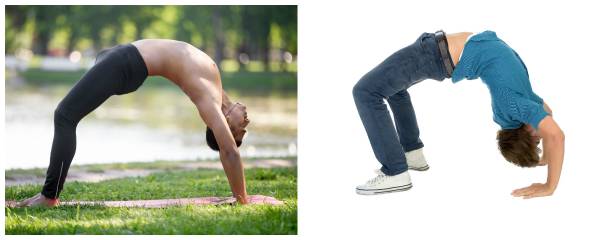As I discussed in part one of this series, most of us have been sitting in chairs since we were young. Sitting in a chair for long periods of time tends to pull the head forward and create rounding in the upper and lower back. After a few years of sitting more than moving, we start to live in that posture, making it harder to extend the upper and lower back while sitting, standing or moving in general.
When I ask new clients what they do most of the day, the answer is almost always “sit in front of a computer.” And it doesn’t stop there. They spend up to nine hours sitting at work. After work, they go home to sit for dinner and television. All sitting. All day.
If I ask them to lift heavy objects over their heads without addressing their immobility first, we will have a problem.
Increase Range of Motion With PNF
Our joints are designed to primarily provide either mobility or stability (though, of course, all joints perform both functions to a degree). Moving from the cervical spine down towards the ankles, the major joint segments alternate between a primary function of stability and mobility. Looking at the diagram below, you can see that the upper thoracic spine generates mobility in flexion/extension and rotation, while the cervical and lumbar spine stabilize around it.
The joint areas of the body alternate in purpose between mobility and stability.
Since most of us basically live in thoracic flexion (think hunched or collapsed posture), our thoracic spine mobility will be severely hindered because we never employ our full range of motion. The joints below and/or above the thoracic spine will be forced to compensate for the lack of movement.
PNF, or proprioceptive neuromuscular facilitation, is one of my favorite ways to increase range of motion. The concept is simple: contract the muscle you are trying to stretch, then release for greater range of movement. This works both the active and passive side of stretching and yields great results.
In the video below, I have given some simple and advanced ways to open the thoracic spine. I suggest working a few of these drills into your daily routine to get the best results. Pick a few that are best suited for you, and slowly work your way into increased range of motion.
Why It Works
In the proper backbend photo below, you can see how upper spine extension and shoulder flexion allow for an even curve. In the other photo, the inability to open the shoulders and upper spine move the extension to the low back and pushes the knees forward. The same thing holds true for overhead lifts. If the spine and shoulders (and/or hips) are not flexible enough, the compensation has to come from above or below the area of restricted mobility.

A proper back bend requires you to open up your thoracic spine, as on the left.
How many times have you heard of someone getting hurt in the low back, shoulders, or neck due to lifting overhead? Overcompensation for a frozen thoracic spine is a major reason why so many people have low back or neck pain and injuries in the gym or on a daily basis. Commit to the drills I showed you above for a period of a few months, and you’ll see dramatic improvement in your overhead lifts.
More Ways to Fight the Hunch:
- Banish Pain Permanently: Basic Drills to Repair your Posture
- Train Your Body to Love Holding Heavy Weights Overhead
- Let’s End the Mobility Versus Stability Debate
- New on Pulse Beat Fit Today
Teaser photo courtesy of Keira Newton.
Other photos courtesy of Shutterstock.






